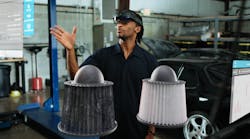When it comes to commercial vehicle maintenance, augmented reality is not the first tool most people would think to find in a shop. But right up with automotive lifts and a trusty wrench, augmented reality (AR) is beginning to find its place in maintenance shops. It's just not quite there yet.
At its most basic, augmented reality consists of technology that overlays a user's physical environment with digital information. This can be done via wearables, like Microsoft's Hololens 2, or a tablet, like Peterbilt's ARTech. Either way, the idea is that technology can provide easier access to information and communication, streamlining their workflow. But while this sounds like an easy pitch, this technology has not yet found a foothold in the commercial vehicle maintenance industry.
Read more: Augmented reality gives assist to vehicle maintenance shopsThus far, there is a delay in the adoption of AR in the commercial vehicle maintenance industry, especially when compared to passenger car shops. According to Fortune Business Insights, the AR-based remote assistance market share for passenger cars was 90% in 2020. Even accounting for the imbalanced consumer ratio between the two markets, the gap is palpable.
Yet the global AR in the automotive market exhibited 12.5% growth in 2020 and is projected to grow from $4.51 billion in 2021 to $14.44 billion in 2028. The latest boom is likely due to the impact of COVID-19, the report stated, leaving the technology’s future growth uncertain as businesses return to normal operation.
“Adoption is significantly lagging,” admitted Matt Johnston, director of commercial solutions for Design Interactive and director of product development, sales, and marketing for XRMentor. “On top of that, I would say that it is lagging even considering the expected and demonstrated return on investment companies are getting already.”
Johnston noted that this lackadaisical response could partially be due to the effort necessary in every organization for the prevalence of AR to increase.
“I think [AR] lags because these companies are extremely busy people, and they perceive this technology as a paradigm shift,” Johnston explained. “I'm not gonna lie to anybody and say that adoption is simple and seamless. It does require a project and an investment of people and resources. Even if the software is not expensive, somebody does have to own it, somebody has to become the internal champion of it. You have to teach people to use it no different than once you had to teach them how to download an app.”
Holly Gerke, VP of maintenance technical training and development at Penske Truck Leasing, expressed a similar statement when discussing how Penske launched their XRMentor training program in the wake of the pandemic.
“Using this technology is really dependent upon the company,” Gerke said. “And the use case really needs to present itself in order for a company to first even try, but then to realize the benefits for it to become a more permanent fixture in the way that they deliver training.”
However, some believe that the sluggish adoption pace could be related to the industry’s natural fear of change, which results in a lot of convincing on the viability of this technology at every level.
“Everything has to be from a trickle-down scenario,” said Ed Chipalowsky, vehicle service and support manager at North American Council for Freight Efficiency (NACFE). “So, I think if we can get a better education [on this technology] and get the fear out of the top, it would greatly enhance [the industry].”
Regardless of whether the automotive industry is resistant to change or unsure if the AR is worth the investment, what remains to be seen is if the impact of the pandemic will be long-lasting for the market. For Andrew Chrostowski, chairman and CEO, RealWear, it’s inevitable that wearable computers will become the norm for frontline workers in general, from diesel technicians to medical professionals.
“I think it won't be long before everyone realizes that if they don’t have their shop outfitted or their technicians connected, they're going to be at a significant disadvantage,” Chrostowski posited. “They're going to be less productive, perhaps working less safely.”
And to back up this assertion, Chrostowski stated that every Ford dealer in the United States had a RealWear device in their bay, an example he noted that most shops can meet today, but in a different form.
“The device cost thresholds [for AR] are now at the same place of ruggedized tablets of any kind, Chrostowski noted. “Connectivity is ubiquitous, it's not like you can't afford internet at your shop.”
If this is the case, perhaps AR will soon be as commonplace a tool as a laptop, an auto lift, or even a wrench, depending on whether the industry is whether to experience a little discomfort in the present for the sake of future productivity.





